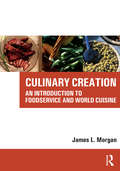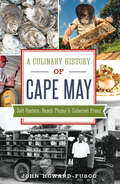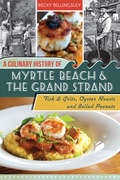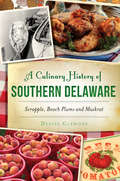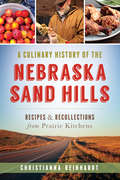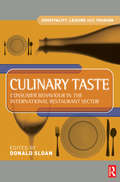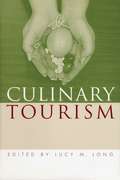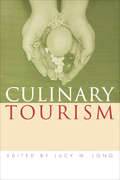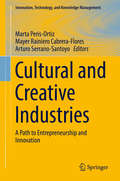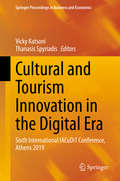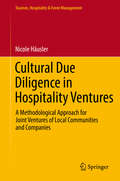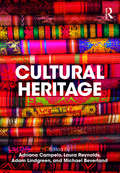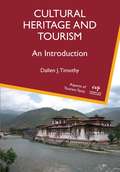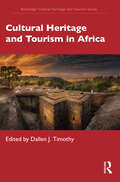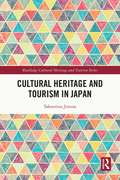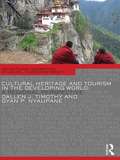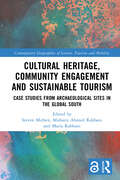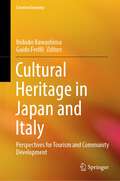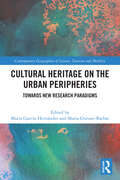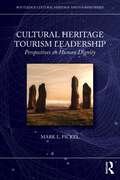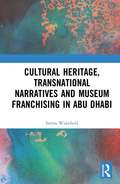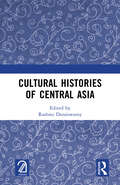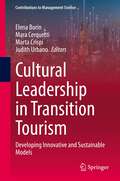- Table View
- List View
Culinary Creation
by James MorganThe book seeks not to present a detailed history and discussion, but instead is intended to provide the student with an appreciation of the idea that all cuisines of the world have something unique to offer to a menu. The author strongly believes that foods of other nations (and even other areas of the United States) are too often given short shrift by culture-bound students and chefs, and that every attempt should be made to open their minds to the unlimited possibilities available. The word “foodism” is introduced to refer to biases against foods outside your culture.
Culinary History of Cape May, A: Salt Oysters, Beach Plums & Cabernet Franc (American Palate)
by John Howard-FuscoCape May is America’s first seaside resort, and with that comes a mouthwatering food history. The New York Times even proclaimed the city “Restaurant Capital of New Jersey.” The first settlers, the Kechemeche of the Lenape tribe, feasted on the fish and wild game in the area. The whaling industry briefly brought attention to the island, but Ellis Hughes’s 1801 advertisement offering seashore entertainment with “fish, oysters, crabs, and good liquors” gave birth to a beachside haven. From the mint juleps to the Sunny Hall Café and the Chalfonte, culinary creativity thrives on the shore. Modern chefs like Lucas Manteca at the Red Store and Brooke Dodds’s Empanada Mamas help keep the unique flair alive. Author John Howard-Fusco traces the roots of the delectable dishes and recipes from long ago to the modern day.
A Culinary History of Myrtle Beach & the Grand Strand: Fish & Grits, Oyster Roasts and Boiled Peanuts (American Palate)
by Becky BillingsleyThe culinary history of Georgetown and Horry Counties reflects a unique merging of Native American, European, African and Caribbean cuisines. Learn how slaves taught their masters to create vast wealth on rice plantations, what George Washington likely ate when visiting South Carolina in 1791, how the turpentine industry gave rise to a sticky sweet potato cooking method and why locals eagerly anticipate one special time of year when boiled peanuts are at their best. Author Becky Billingsley, a longtime Myrtle Beach-area restaurant journalist, digs deep into historic records, serves up tantalizing personal interviews and dishes on the best local restaurants, where many delicious farm-to-table heritage foods can still be enjoyed.
A Culinary History of Southern Delaware: Scrapple, Beach Plums and Muskrat (American Palate)
by Denise ClemonsHistoric farms and waterways crisscross Southern Delaware, connecting its residents to a set of rich culinary traditions. The original Nanticoke inhabitants baked hearty johnnycakes and hunted wild game. Hungry for a taste of home, German settlers developed scrapple from local ingredients. Today's home cooks and chefs draw their bounty from the land and sea for a distinct, seasonal cuisine. Summer strawberries and peaches from local farms and orchards become delectable preserves thanks to treasured family recipes. Come springtime, succulent blue crab reigns supreme. With recipes for regional favorites like beach plum jelly and chicken with slippery dumplings, author Denise Clemons explores the history behind the ingredients and savors the story in every dish.
A Culinary History of the Nebraska Sand Hills: Recipes & Recollections from Prairie Kitchens (American Palate)
by Christianna ReinhardtSpanning nineteen thousand square miles of central Nebraska, the Sand Hills--North America's largest sand dune--is held in place by only a thin, sturdy layer of native prairie grasses and continuing faith that the land can be made prosperous by its residents. Settlers in the area had to be hardy and resourceful, making use of what the land provided and holding fast when their hard work blew away with the prairie winds. From foraging to ranching, food meant survival, but it also meant community. Staples like fried chicken, biscuits, fruit pies, preserves and cakes all play a role in the fascinating story of the region. Join food writer Christianna Reinhardt as she dishes up the unique and tasty history of this exceptional part of the world.
Culinary Taste: Consumer Behaviour In The International Restaurant Sector (Hospitality, Leisure And Tourism Ser.)
by Prue Leith Donald SloanCulinary Taste: Consumer Behaviour in the International Restaurant Sector looks at the factors that influence our culinary tastes and dining behaviour, illustrating how they can translate into successful business in industry.With a foreword from Prue Leith, restaurateur, author, teacher, and prolific cookery writer and novelist, and a list of well-known and respected international contributors from the UK, France, Australia and Hong Kong, this text discusses the issues involved from a multitude of angles.
Culinary Tourism
by Lucy M. LongCulinary Tourism is the first book to consider food as both a destination and a means for tourism. The book's contributors examine the many intersections of food, culture and tourism in public and commercial contexts, in private and domestic settings, and around the world. The contributors argue that the sensory experience of eating provides people with a unique means of communication. Editor Lucy Long contends that although the interest in experiencing ""otherness"" is strong within American society, total immersion into the unfamiliar is not always welcome. Thus spicy flavors of Latin Aermcia and the exotic ingredients of Asia have been mainstreamed for everyday consumption. Culinary Tourism explains how and why interest in foreign food is expanding tastes and leading to commercial profit in America, but the book also show how tourism combines personal experiences with cultural and social attitudes toward food and the circumstances for adventurous eating.
Culinary Tourism (Material Worlds)
by Lucy M. Long&“Well-researched and original&” essays on the intersection between food and adventure (Publishers Weekly). Culinary Tourism is the first book to consider food as both a destination and a means for tourism. The book&’s contributors examine the many intersections of food, culture, and tourism in public and commercial contexts, in private and domestic settings, and around the world. The contributors argue that the sensory experience of eating provides people with a unique means of communication—whether they&’re trying out a new kind of ethnic restaurant in their own town or the native cuisine of a place far from home. Editor Lucy Long explains how and why interest in foreign food is expanding tastes and leading to commercial profit in America, but the book also shows how tourism combines personal experiences with cultural and social attitudes toward food and the circumstances that allow for adventurous eating. &“Contributors to the book are widely recognized food experts who encourage readers to venture outside the comforts of home and embark on new eating experiences.&” —Lexington Herald-Leader
Culloden, 1746: Battlefield Guide: Third Edition (Battleground Scotland Ser.)
by Stuart ReidA journey to the Highland battlefield where this landmark event in Scottish history took place, with numerous maps and illustrations. Culloden Moor is one of the most famous battles in British history and, for the Scots, the battle is pre-eminent, surpassing even Bannockburn. In this decisive and bloody encounter in 1746, the Duke of Cumberland&’s government army defeated the Jacobite rebels led by Prince Charles Edward Stuart. Yet, despite the attention paid to this critical event—in particular to Bonnie Prince Charlie and the Jacobite legend—few writers have concentrated on the battle itself and on the Highland battlefield on which it was fought. Stuart Reid, in this revised third edition of his bestselling guide, does just that. He tells the story of the campaign and sets out in a graphic and easily understood way the movements and deployments of the opposing forces, and he describes in vivid detail the deadly combat that followed. Incorporating the latest documentary and archaeological research and featuring a completely new and expanded section on the armies, it also invites visitors to explore for themselves this historic ground on which the tragic battle was fought.
Cultural and Creative Industries: A Path to Entrepreneurship and Innovation (Innovation, Technology, and Knowledge Management)
by Marta Peris-Ortiz Mayer Rainiero Cabrera-Flores Arturo Serrano-SantoyoThis book examines the ways in which cultural and creative industries can drive entrepreneurship, innovation, sustainability and overall regional development. It will address such issues as (1) the technical (tangible) components of creative and cultural industries in relation to innovation; (2) the intangible components of creative and cultural industries in relation to services provided; (3) the relationship between tangible and intangible components and economic and social innovation; and (4) the ways in which creative and cultural industries effect and influence regional sustainability and development.Cultural and creative industries and the creative economy as a whole have been increasingly prevalent in research literature because of their role in driving economic and social development. Cultural and creative industries also enable other forms of entrepreneurship and innovation beyond the traditional, technology-based focus of innovation, thereby enhancing regional growth and development through these channels. The contributions presented in this book discuss the main issues, challenges, opportunities and trends of cultural and creative industries through conceptual analysis and cases studies from different world regions. Featuring research from industries such as art, health care, beer and wine and education, this book provides researchers, academics, professionals and policy makers with a detailed examination of the development and potential of cultural and creative industries in regional and global economies.
Cultural and Heritage Tourism in the Middle East and North Africa: Complexities, Management and Practices (Contemporary Geographies of Leisure, Tourism and Mobility)
by Milenka Linneth Argote Cusi León Darío Parra BernalThis is the first book to provide a comprehensive account of cultural and heritage tourism in the Middle East and North Africa (MENA) region and the many complexities that heritage sites and tourist attractions face. The MENA region has long been regarded as the cradle of Western and Arab civilisation and is the home of many of the world’s major religions. Because of this, the region is rich in heritage sites that serve as major tourist attractions and as icons of national, cultural and religious identity. However, as this book examines, heritage in the region is simultaneously highly contested and has even become a target for terrorism creating a situation that brought major challenges for heritage management and sustainable tourism development. Many of the region’s innumerable cultural sites are threatened, in some cases by overuse, in others by neglect and, in many, simply by the pressures of economic development. This book is therefore of interest not only to heritage managers and policy makers but those academics who seek to address the delicate balance between tourism development, communities and the tourists who visit such sites in a turbulent but highly significant region of the world.
Cultural and Tourism Innovation in the Digital Era: Sixth International IACuDiT Conference, Athens 2019 (Springer Proceedings in Business and Economics)
by Vicky Katsoni Thanasis SpyriadisThis book explores a wide range of emerging cultural, heritage, and other tourism issues that will shape the future of hospitality and tourism research and practice in the digital and innovation era. It offers stimulating new perspectives in the fields of tourism, travel, hospitality, culture and heritage, leisure, and sports within the context of a knowledge society and smart economy. A central theme is the need to adopt a more holistic approach to tourism development that is aligned with principles of sustainability; at the same time, the book critically reassesses the common emphasis on innovation as a tool for growth-led and market-oriented development. In turn, fresh approaches to innovation practices underpinned by ethics and sustainability are encouraged, and opportunities for the exploration of new research avenues and projects on innovation in tourism are highlighted. Based on the proceedings of the Sixth International Conference of the International Association of Cultural and Digital Tourism (IACuDiT) and edited in collaboration with IACuDiT, the book will appeal to a broad readership encompassing academia, industry, government, and other organizations.
Cultural Due Diligence in Hospitality Ventures
by Nicole HäuslerThis book introduces readers to a powerful method for cross-cultural due diligence in mergers and organizational collaborations. It employs the context of joint ventures between local communities and companies in the domain of hospitality in emerging tourism destinations. The book first analyzes the impact of cultural diversity in mergers between local communities and the private sector, revealing the characteristics and functions of culture and paying specific attention to the roles of organizational and community cultures in hospitality. In two subsequent methodological chapters the book presents a theoretical framework for cultural due diligence and identifies the principal actors, technical aspects and core principles. On the basis of a separate case study from northern Thailand, the book provides an example of cultural context analysis and presents the findings and results. In a concluding chapter the book presents an outlook on further research and development in this field.
Cultural Heritage
by Adriana Campelo Laura Reynolds Adam Lindgreen Michael BeverlandCultural Heritage is a systematic, interdisciplinary examination of cultural heritage, which provides an up-to-date view of the field by drawing on various disciplines. The book offers a thorough, structured review of extant literature on heritage in tourism and pertinent challenges for cultural heritage. This book offers new ways of looking at cultural heritage assets against a backdrop of increasing economic and environmental pressures. It comprises a number of sections that each examine cultural heritage from the perspective of ethics and values, community relations and development, cultural entrepreneurship, economic viability and conservation, methodologies, impacts of tourism research, consumption, and urban and immaterial heritage. Encompassing global research perspectives from public management, visual culture, environmental management, and cultural entrepreneurship, Cultural Heritage is a crucial text for those working or interested in the heritage field.
Cultural Heritage and Tourism
by Dallen J. TimothyOne of the most salient forms of modern-day tourism is based on the heritage of humankind. The majority of all global travel entails some element of the cultural past, as hundreds of millions of people visit cultural attractions, heritage festivals, and historic places each year. The book delves into this vast form of tourism by providing a comprehensive examination of its issues, current debates, concepts and practices. It looks at the social, physical and economic impacts, which cause destinations, site managers and interpreters to consider not only how to plan and manage resources but also how to portray the past in ways that are acceptable, accurate, accessible and politically relevant. In the process, however, the depth of heritage politics, the authenticity and inauthenticity of place and experience, and the urgent need to protect living and built cultures are exposed. The book explores these and many other current issues surrounding the management of cultural resources for tourism. In order to help students relate concepts to real-world situations it combines theory and practice, is student learning oriented, is written accessibly for all readers and is empirically rich.
Cultural Heritage and Tourism in Africa (Routledge Cultural Heritage and Tourism Series)
by Dallen J. TimothyCultural Heritage and Tourism in Africa examines the multiple and diverse manifestations of cultural heritage-based tourism in Africa from a regional, social science, and sustainability perspective. This book delivers a comprehensive treatise on the interdependent concepts of cultural heritage and tourism. Heritage is one of the most pervasive tourism assets worldwide and lies at the foundations of tourism in many localities, including Africa. However, despite its salience, there has not been a systematic examination of Africa’s heritage resources, markets, policies, practices, successes, and challenges in a tourism framework, despite the continent’s immense heritage value. This book reviews the different types of heritages that pervade the cultural environment of Africa and comprises its vast heritagescapes. It also examines the increasing potential for the growth of heritage tourism throughout the entire continent. The contributions in this volume delve into current thinking about space and place and their effects on heritage, mobilities, globalization, colonialism and indigeneity, conflict, identity and nation-building, connections with other regions through migration and the slave trade, and a greater emphasis on the ordinary heritage of Africa, which has long been ignored by tourism scholars and industry representatives. The chapters herein are authored by Africa specialists, most being from Africa, offering a truly African perspective. The chapters are conceptually rigorous and empirically rich with examples from all regions of the African continent. This unparalleled interdisciplinary glimpse at cultural heritage and tourism in Africa delivers strong value and is a vital resource for all students and researchers of tourism, cultural studies, heritage studies, geography, anthropology, sociology, history, and global studies.
Cultural Heritage and Tourism in Japan (Routledge Cultural Heritage and Tourism Series)
by Takamitsu JimuraThis book offers a comprehensive understanding of cultural heritage in Japan and its relationship with both domestic and international tourism. Japan has witnessed an increase in tourism, with rising visitor numbers to both established destinations and lesser known sites. This has generated greater attention towards various aspects of Japanese culture, heritage and society. This book explores these diverse aspects of everyday life in Japan and their interconnections with tourism. It begins with a conceptual framework of key theories related to heritage and tourism, serving as a useful apparatus for further discussions in the following chapters. Each chapter studies a specific aspect of Japan’s cultural heritage, from the history of Japan, the development of war sites, such as Hiroshima and Nagasaki, to tourist destinations, indigenous communities and their places of residence, festivals such as matsuri, to popular culture and media. Each chapter discusses a certain type of cultural heritage first in a global context and then examines it in a Japanese context, aiming to demonstrate the relation between these two different contexts. In each chapter, furthermore, how a particular kind of Japan’s cultural heritage is utilised as tourism resources and how it is perceived and consumed by international and domestic tourists are discussed. Finally, the book revisits the conceptual framework to suggest future directions for cultural heritage and tourism in Japan. Written in an informative and accessible style, this book will be of interest to scholars, students and practitioners in the fields of tourism, cultural studies and heritage studies.
Cultural Heritage and Tourism in the Developing World: A Regional Perspective (Contemporary Geographies of Leisure, Tourism and Mobility)
by Dallen J. Timothy Gyan P. NyaupaneCultural Heritage and Tourism in the Developing World is the first book of its kind to synthesize global and regional issues, challenges, and practices related to cultural heritage and tourism, specifically in less-developed nations. The importance of preservation and management of cultural heritage has been realized as an increasing number of tourists are visiting heritage attractions. Although many of the issues and challenges developing countries face in terms of heritage management are quite different from those in the developed world, there is a lack of consolidated research on this important subject. This seminal book tackles the issues through theoretical discourse, ideas and problems that underlay heritage tourism in terms of conservation, management, economics and underdevelopment, politics and power, resource utilization, colonialism, and various other antecedent notions that have shaped the development of heritage tourism in the less-developed regions of the world. The book is comprised of two sections. The first section highlights the broader conceptual underpinnings, debates, and paradigms in the realm of heritage tourism in developing regions. The chapters of this section examine heritage resources and the tourism product; protecting heritage relics, places and traditions; politics of heritage; and the impacts of heritage tourism. The second section examines heritage tourism issues in specific regions, including the Pacific Islands, South Asia, the Caribbean, China and Northeast Asia, South-East Asia, Sub-Saharan Africa, Central and Eastern Europe, the Middle East and North Africa, and Latin America. Each region has unique histories, cultures, political traditions, heritages, issues and problems, and the way these issues are tackled vary from place to place. This volume develops frameworks that are useful tools for heritage managers, planners and policy-makers, researchers, and students in understanding the complexity of cultural heritage and tourism in the developing world. Unlike many other books written about developing regions, this book provides insiders’ perspectives, as most of the empirical chapters are authored by the individuals who live or have lived in the various regions and have a greater understanding of the region’s culture, history, and operational frameworks in the realm of cultural heritage. The richness of this ‘indigenous’ or expert knowledge comes through as each regional overview elucidates the primary challenges and opportunities facing heritage and tourism managers in the less affluent areas of the world.
Cultural Heritage, Community Engagement and Sustainable Tourism: Case Studies from Archaeological Sites in the Global South (Contemporary Geographies of Leisure, Tourism and Mobility)
by Steven Mithen Mubariz Ahmed Rabbani Maria RabbaniThis timely and innovative book critically explores how cultural heritage in the Global South can be used to mobilise community engagement and promote sustainable tourism at archaeological sites.Whilst the volume covers theoretical issues, it primarily offers insight into how both small and large projects within low- and middle-income countries start, plan and develop. It describes what factors lead some projects to succeed, some to fail and most to have elements of both. Core to this investigation, each specifically commissioned chapter considers the challenges of developing collaboration and joint ownership between multiple stakeholders, ranging from local communities to national governments. In addition, the book considers how the challenges of the COVID-19 pandemic were managed, with lessons for future events of such magnitude. In summary, this significant volume recognises the value of developing collaborative partnerships between academics, NGOs and local communities, to achieve community engagement within archaeological research and support sustainable development by developing appropriate forms of tourism at archaeological sites. It provides essential reading for those interested in tourism, heritage studies, archaeology, geography, tourism studies and cultural studies.The Open Access version of this book, available at http://www.taylorfrancis.com, has been made available under a Creative Commons [Attribution-Non Commercial-No Derivatives (CC BY-NC-ND)] 4.0 license.
Cultural Heritage in Japan and Italy: Perspectives for Tourism and Community Development (Creative Economy)
by Nobuko Kawashima Guido FerilliThis edited book represents one of the first scholarly research through an international collaboration project between Japan and Italy to address economic and social values of cultural heritage beyond its inherent—historic, archaeological, or aesthetic—values. Cultural policies in the world have over the decades expanded to include non-cultural purposes such as economic development and social inclusion. Japanese cultural policy for heritage is catching up on this trend: we have seen major shifts of emphasis from preservation for its sake to the utilisation of cultural heritage for the purposes of tourism, place branding, local vitalization and community-building, whilst Italy has long thrived on the economy of heritage tourism and more cases are being seen for urban and regional development with the use of cultural assets. The recent outbreak of Covid-19 and the problem of over-tourism that preceded it have challenged tourism policy and practice in the two countries.This book identifies emerging trends, issues, and problems in such policy shifts. The book breaks a new ground in the bourgeoning studies of tourism, heritage, and cultural policy by adopting an international, inter-disciplinary approach. The chapters on Japan in particular make an original contribution to these fields in the English literature in which discussion of Japan despite its economic and cultural presence on the globe has hitherto been less available.
Cultural Heritage on the Urban Peripheries: Towards New Research Paradigms (Contemporary Geographies of Leisure, Tourism and Mobility)
by Maria Gravari-Barbas María García-HernándezThis innovative and insightful book critically explores how to recognize and generate the social, cultural, political and economic values of the heritage of urban peripheries and encourage new metropolitan development scenarios that protect and build upon that cultural heritage.Expert-led and richly illustrated throughout, the text addresses issues such as the management and development of the cultural heritage of urban peripheries, community involvement, the relationship of youth with cultural heritage, the heritage of ethnic communities and their cultural identity, tourism development supported by heritage resources and the art-heritage relationship at urban peripheries. It looks at the whole spectrum of heritage of the metropolitan peripheries including architectural heritage (industrial areas, factories and warehouses); transport infrastructure (canals and railways); social housing, and contemporary residential architecture. It also comprises the rich intangible heritages of working-class and/or migrant communities, in process of constant change and reconfiguration through protest, negotiation and cultural expression. This significant volume reveals the heterogeneity of the existing cultural heritage in the urban peripheries, the complexity of the processes of recognition and social appropriation of these assets as well as their need for protection.This is a pivotal resource for students, scholars and academics of urban studies, tourism studies and cultural studies, as well as those with an interest in these topics more generally.
Cultural Heritage Tourism Leadership: Perspectives on Human Dignity (Routledge Cultural Heritage and Tourism Series)
by Mark L. PickelThis book proposes a novel transformational humanistic leadership approach applied to cultural heritage tourism, based on humanistic values of human dignity, creativity, and autonomy and supported by a distinctive leadership ethos, purpose, and guiding principles that promote the betterment of society.By reimagining how cultural heritage tourism leadership upholds human dignity through tour experiences that generate moments of grounding, reflection, understanding, and healing, humanistic leadership provides an ethical framework and strategic alignment to encourage human flourishing. In proposing a pluralistic leadership ethic that unites social, ecological, and technological influences, the impact of cultural heritage tourism on visitors’ human dignity is considered, culminating in transformational humanistic leadership that promotes tourism sustainability, authenticity, and adaptability. Practical leadership challenges are explored through case studies and leadership inquiries that reflect the cultural complexity of international heritage tourism, including Avebury Neolithic stone henge in the United Kingdom, Caerleon Roman Fortress and Baths in Wales, the Museum of the Cherokee People in the United States, and the Meissen Porcelain Manufactory in Germany.Cultural heritage tourism leaders, public history and anthropology scholars, those interested in applied humanism in heritage contexts, and leadership ethicists will benefit from reflecting on human dignity as a central tenant of transformational humanistic leadership.
Cultural Heritage, Transnational Narratives and Museum Franchising in Abu Dhabi
by Sarina WakefieldThis publication contributes to new understandings of how heritage operates as a global phenomenon and the transnational heritage discourses that emerge from this process. Taking such a view sees autochthonous and franchised heritage not as separate or opposing elements but as part of the same process of contemporary globalised identity-making, which contributes to the development of newly emergent cosmopolitan identities. The book critically examines the processes that are involved in the franchising of heritage and its cultural effects. It does so by examining the connections and tensions that emerge from combining autochthonous and franchised heritage in the United Arab Emirates, providing a unique window in to the process of creating hybrid heritage in non-Western contexts. It develops new ideas about how this global phenomenon works, how it might be characterised and how it influences and is itself affected by local forms of heritage. By exploring how autochthonous and franchised heritage is produced in Abu Dhabi in the United Arab Emirates it becomes clear that Western-dominated practices are often challenged and, perhaps more importantly, that new ways of understanding, producing and living with heritage are being articulated in these previously marginal locations. The book offers innovative insights into heritage as a transnational process, exploring how it operates within local, national and international identity concerns and debates. It will appeal to scholars and students interested in critical heritage studies, museums, tourism, cultural studies and Middle Eastern studies.
Cultural Histories of Central Asia
by Rashmi DoraiswamyCentral Asia, the 'heart' of the Eurasian landmass, has through the centuries been the hub of diverse and varied cultures. These cultures have encompassed pre-Islamic religions and Islam, sedentary and nomadic lifestyles and lived through rapid transitions from feudal, capitalist and socialist economies, from Tsarist to Soviet and post-Soviet formations. The essays in this volume examine the cultural exchanges and encounters that have occurred in the region through a vast timeline that extends from the premedieval to the medieval and modern periods. The writers are academics, as well as art practitioners and independent researchers who belong to a wide spectrum of disciplines: Central Asian and Russian Studies, Architecture, Ethno-Musicology, History, Painting, Film Studies, Art History, Textiles, Literature and International Relations. The volume presents a colourful mosaic of views on the many cultural histories of Central Asia.
Cultural Leadership in Transition Tourism: Developing Innovative and Sustainable Models (Contributions to Management Science)
by Elena Borin Mara Cerquetti Marta Crispí Judith UrbanoCultural tourism has proved to be a significant source of economic development for cultural destinations, but it has also emerged as a sometimes potentially controversial and unsustainable phenomenon. The recent pandemic has also pointed out that we need different models of development of tourism, that include a more balanced approach to cultural components in cities and rural areas. Calls have been made on the need to design more sustainable models of tourism development for cultural destinations, conceiving tourism as a means to increasing the quality of life and generating economic opportunities in cities and regions by involving their communities and stakeholders. This book presents an in-depth analysis of the transition towards more sustainable models of cultural tourism development. Starting from the ongoing debate on cultural ecosystems, the book explores the potential key role of cultural and creative organizations as leaders of change. Including theoretical contributions, quantitative and qualitative analyses and international case studies, the book explores the role of cultural actors as leaders and their potential as drivers of culture-led innovation for tourism in cities and regions.
